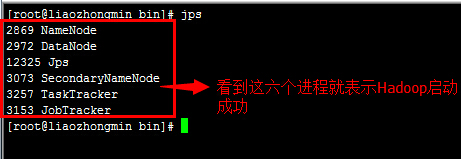Java API操作HDFS
Posted
tags:
篇首语:本文由小常识网(cha138.com)小编为大家整理,主要介绍了Java API操作HDFS相关的知识,希望对你有一定的参考价值。
HDFS是存储数据的分布式文件系统,对HDFS的操作,就是对文件系统的操作,除了用HDFS的shell命令对文件系统进行操作,我们也可以利用Java API对文件系统进行操作,比如文件的创建、删除、修改权限等等,还有文件夹的创建、删除、重命名等等。
使用Java API对文件系统进行操作主要涉及以下几个类:
1.Configuration类:该类的对象封装了客户端或者服务端的配置。
2.FileSystem类:该类的对象是一个文件系统对象,可以利用该对象的一些方法来对文件进行操作,FileSystem是一个抽象,不能通过new来获取对象,应该通过Filesystem的静态方法get()来获取:
- //创建URI对象
- //PATH = "hdfs://liaozhongmin:9000/";
- URI uri = new URI(PATH);
- //获取文件系统
- FileSystem fileSystem = FileSystem.get(uri, new Configuration());
3.FSDataInputStream和FSDataOutputStream:这两个类是HDFS中的输入输出流。分别通过FileSystem的open()方法和create()方法获得。
在使用Java API 操作HDFS之前,首先要保证hadoop是正常启动的,可以通过jps命令来查看hadoop的进程是否全部启动,如下图:

注:如上图所示,使用jps命令可以看到Hadoop的五个进程即NameNode、DataNode、SecondaryNameNode、TaskTrackers、JobTracker启动了,就表示hadoop启动成功了。
下面是关于Java API操作HDFS文件系统的常用工具类:
- public class FileSystemUtil {
- //定义HDFS的路径
- private static final String PATH = "hdfs://liaozhongmin:9000/";
- /**
- * 获取文件系统FileSystem
- * @return
- */
- public static FileSystem getFileSystem(){
- try {
- //创建URI对象
- //PATH = "hdfs://liaozhongmin:9000/";
- URI uri = new URI(PATH);
- //获取文件系统
- FileSystem fileSystem = FileSystem.get(uri, new Configuration());
- return fileSystem;
- } catch (Exception e) {
- e.printStackTrace();
- }
- return null;
- }
- /**
- * 创建文件夹
- * @param fileSystem
- */
- public static void mkdir(FileSystem fileSystem,String path){
- try {
- //创建Path对象
- Path srcPath = new Path(path);
- //通过文件系统对象创建文件夹
- fileSystem.mkdirs(srcPath);
- } catch (IOException e) {
- e.printStackTrace();
- } finally{
- try {
- fileSystem.close();
- } catch (IOException e) {
- e.printStackTrace();
- }
- }
- }
- /**
- * 创建新文件
- * @param dst
- * @param contents
- */
- public static void createFile(String dst,byte[] contents){
- //定义文件系统
- FileSystem fileSystem = null;
- //定义输出流
- FSDataOutputStream outputStream = null;
- try {
- //获取文件系统
- fileSystem = FileSystemUtil.getFileSystem();
- //创建一个目标路径
- Path path = new Path(dst);
- //创建文件
- outputStream = fileSystem.create(path);
- //写数据
- outputStream.write(contents);
- System.out.println("文件创建成功!");
- } catch (IOException e) {
- e.printStackTrace();
- } finally{
- //关闭
- try {
- fileSystem.close();
- outputStream.close();
- } catch (IOException e) {
- e.printStackTrace();
- }
- }
- }
- /**
- * 向文件系统中上传本地数据
- * @param fileSystem
- */
- public static void putData(FileSystem fileSystem,String src,String dst){
- try {
- //创建原路径Path对象
- Path srcPath = new Path(src);
- //创建目标路径Path对象
- Path dstPath = new Path(dst);
- //调用文件系统的文件爱你复制函数,前面的参数是指是否删除源文件,true为删除,否则不删除
- fileSystem.copyFromLocalFile(false, srcPath, dstPath);
- } catch (IOException e) {
- e.printStackTrace();
- } finally{
- //关闭文件系统
- try {
- fileSystem.close();
- } catch (IOException e) {
- e.printStackTrace();
- }
- }
- }
- /**
- * 文件重命名
- * @param oldName 旧名字
- * @param newName 新名字
- */
- public static void rename(FileSystem fileSystem,String oldName,String newName){
- try {
- //创建旧文件的Path对象
- Path oldPath = new Path(oldName);
- Path newPath = new Path(newName);
- //重命名
- fileSystem.rename(oldPath, newPath);
- } catch (Exception e) {
- e.printStackTrace();
- } finally{
- try {
- fileSystem.close();
- } catch (IOException e) {
- e.printStackTrace();
- }
- }
- }
- /**
- * 下载文件
- * @param fileSystem
- * @param fileName
- */
- public static void getData(FileSystem fileSystem,String src,String dst){
- try {
- //创建Path对象
- Path path = new Path(src);
- //通过path构建文件系统的输入流
- FSDataInputStream in = fileSystem.open(path);
- //构建文件
- File file = new File(dst);
- if (!file.exists()){
- file.createNewFile();
- }
- //构建输出流
- FileOutputStream fileOutputStream = new FileOutputStream(file);
- //下载
- IOUtils.copyBytes(in, fileOutputStream, 1024, true);
- } catch (IOException e) {
- e.printStackTrace();
- }
- }
- /**
- * 遍历文件系统中的某个目录
- * @param fileSystem
- */
- public static void listFile(FileSystem fileSystem,String path){
- try {
- //调用listStatus()方法获取一个文件数组
- FileStatus[] listStatus = fileSystem.listStatus(new Path(path));
- //循环遍历
- for (FileStatus fileStatus : listStatus){
- //判断是否为目录
- String isDir = fileStatus.isDir()?"是文件夹":"是文件";
- //获取文件的权限
- String permission = fileStatus.getPermission().toString();
- //获取备份
- short replication = fileStatus.getReplication();
- //获取数组的长度
- long len = fileStatus.getLen();
- //获取文件的路径
- String filePath = fileStatus.getPath().toString();
- //打印数据
- System.out.println("isDir:" +isDir + "\npermission:" + permission + "\nreplication:" + replication+ "\nlen:" + len + "\nfilepath:" + filePath);
- }
- } catch (IOException e) {
- e.printStackTrace();
- }
- }
- /**
- * 删除文件
- * @param fileSystem
- */
- public static void remove(FileSystem fileSystem,String filePath){
- try {
- //创建path对象
- Path path = new Path(filePath);
- //通过文件系统进行删除,第二个参数设置为true时才可以删除为目录的文件,否则的话如果是目录而不是文件就会报错的
- fileSystem.delete(path, true);
- } catch (IOException e) {
- e.printStackTrace();
- }
- }
- /**
- * 工具类的测试
- * @param args
- */
- public static void main(String[] args) {
- //创建文件系统
- FileSystem fileSystem = getFileSystem();
- //创建文件夹
- //FileSystemUtil.mkdir(fileSystem, "/myDir");
- //创建文件并写入内容
- //byte[] contents = "我爱你".getBytes();
- //FileSystemUtil.createFile("/myDir/liao.txt", contents);
- //文件重命名
- //FileSystemUtil.rename(fileSystem, "/myDir/liao.txt", "/myDir/liao_bak");
- //上传文件
- //FileSystemUtil.putData(fileSystem, "D:\\android\\test.txt", "/myDir");
- //下载文件
- //FileSystemUtil.getData(fileSystem, "/myDir/test.txt", "D:\\test.txt");
- //遍历文件系统的某个目录
- //FileSystemUtil.listFile(fileSystem, "/");
- //删除文件
- FileSystemUtil.remove(fileSystem, "/dir/liaozhongmin.txt");
- }
- }
注:远程文件系统的路径,请自行在hadoop/conf/core-site.xml文件中配置:
- <?xml version="1.0"?>
- <?xml-stylesheet type="text/xsl" href="configuration.xsl"?>
- <!-- Put site-specific property overrides in this file. -->
- <configuration>
- <property>
- <name>fs.default.name</name>
- <!--文件系统的路径-->
- <value>hdfs://liaozhongmin:9000</value>
- </property>
- <property>
- <name>hadoop.tmp.dir</name>
- <!--文件保存的位置(上传后以块的形式保存)-->
- <value>/usr/local/hadoop/tmp</value>
- </property>
- </configuration>
以上是关于Java API操作HDFS的主要内容,如果未能解决你的问题,请参考以下文章